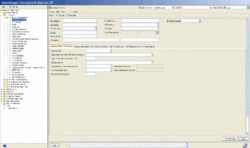Difference between revisions of "Deployment Service"
The Wiki of Unify contains information on clients and devices, communications systems and unified communications. - Unify GmbH & Co. KG is a Trademark Licensee of Siemens AG.
(→Most important DLS features) |
(→Capacity Limits and Restrictions (based on currently released version DLS V1 R2)) |
||
| Line 26: | Line 26: | ||
In addition to standard DLS-GUI based operation, most DLS functions can also be operated by external applications over a web service interface, the [[DlsAPI]]. | In addition to standard DLS-GUI based operation, most DLS functions can also be operated by external applications over a web service interface, the [[DlsAPI]]. | ||
| − | == Capacity Limits and Restrictions | + | == Capacity Limits and Restrictions == |
* Maximum number of SIP devices supported: 20000 (for details see scalability information in the release note) | * Maximum number of SIP devices supported: 20000 (for details see scalability information in the release note) | ||
| − | |||
* Full [[Plug&Play]] functionality requires a [[DHCP]]/[[DNS]] infrastructure in the network, which has been configured for operation with the DLS. | * Full [[Plug&Play]] functionality requires a [[DHCP]]/[[DNS]] infrastructure in the network, which has been configured for operation with the DLS. | ||
* You can only install one DLS per DHCP domain in the network. | * You can only install one DLS per DHCP domain in the network. | ||
Revision as of 12:51, 31 May 2007
The Deployment Service (DLS) is a HiPath Management application for administering the following IP Devices (both SIP and HFA) in HiPath and non-HiPath networks:
- IP Phones: OpenStage, optiPoint (except optiPoint 150 S)
- IP Clients: optiClient 130
Contents
Most important DLS features
- Inventory management: The DLS is the central inventory data manager for IP Devices. Inventory data describes the hardware configuration and capacity of the IP Phones and includes information on items, such as add-on devices or adapters available.
- Configuration management: DLS is a user-friendly tool to read and modify configuration of IP Devices. Changes can be done on individual IP Devices, as well as on groups of IP Devices using DLS table view and the bulk change feature.
- Software deployment: DLS allows easy software upgrade of IP Phones to a specific version or the latest SW version available.
- Plug&Play function: The DLS supports Plug&Play, that is automatic configuration of a phone as well as provision with up-to-date software on phone startup.
- User Mobility for IP phones (only released for HiPath 8000 solutions and pure SIP environment): With the mobility feature, a user's personal configuration and data, for instance key layout, phonebook, or call lists, becomes portable. The user data is stored and deployed on demand by the DLS.
The DLS is designed as a client/server application. The client (DLS-GUI: Graphical User Interface) is written in Java and requires MS Internet Explorer as browser and JRE as Java runtime engine.
The server is also written in Java. Two DLS server variants are available:
- DLS as standalone installation on MS Windows 2003 or XP
- DLS installed on-oboard on a HiPath 8000 platform. (DLS is delivered with HiPath 8000 Assistant DVD.)
In addition to standard DLS-GUI based operation, most DLS functions can also be operated by external applications over a web service interface, the DlsAPI.
Capacity Limits and Restrictions
- Maximum number of SIP devices supported: 20000 (for details see scalability information in the release note)
- Full Plug&Play functionality requires a DHCP/DNS infrastructure in the network, which has been configured for operation with the DLS.
- You can only install one DLS per DHCP domain in the network.
- The DLS user interface is available in German and English.
Documentation
|
Online Help / Administration Manual
DLS is shipped with a comprehensive context-sensitive online help. This documentation is also available as PDF file.
The most up-to-date version is always part of the latest DLS delivery.
On installation unit of DLS V1 (Windows variant), you find it at: program files\DeploymentService\doc
Latest version for download:
DlsAPI
Documentation of the DLS WebService interface:





